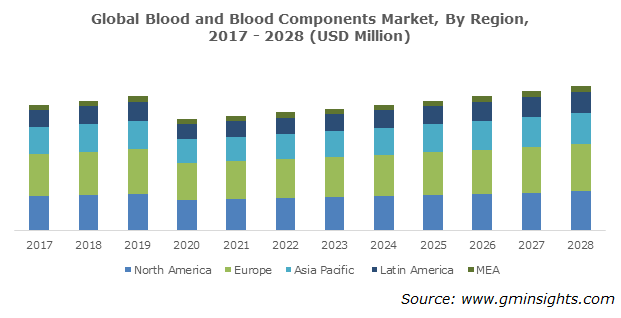Home > Healthcare > Pharmaceuticals > Finished Drug Form > Blood and Blood Components Market
Blood and Blood Components Market Analysis
- Report ID: GMI3067
- Published Date: Apr 2022
- Report Format: PDF
Blood and Blood Components Market Analysis
Majority of cancer patients require transfusion of blood and blood components i.e., red blood cells as they also suffer from chronic anaemia condition. Cancer, particularly of digestive system leads to internal bleeding, thereby requiring blood component transfusion. Blood cells are produced in bone marrow however, in case of leukaemia or cancers that affect bone marrow function result in low blood count.
According to the American Cancer Society, there are over 60,000 new cases of leukaemia in the U.S. in 2022. Condition namely, anaemia is caused due to prolonged medical condition that negatively impacts the production and normal functioning of red blood cells.
Additionally, surgeries to treat certain type of cancer might also lead to blood loss, thereby lowering the blood cell count. Majority of chemotherapy drugs, radiation to treat large portion of bones also affect bone marrow, thereby lowering the overall blood cell counts that is set to prove beneficial for the blood and blood components market statistics.
By product, the market is segmented into whole blood and blood components. The blood components segment is further bifurcated into red blood cells, platelets, plasma, and white blood cells. Blood components segment accounted for over USD 11.6 billion market revenue in 2021. Blood components are essential during various surgeries and blood loss situations.
Moreover, certain conditions such as leukaemia or prolonged cancer treatment disrupts the production of blood components in bone marrow. Thus, requiring external supply of these components. Furthermore, aesthetic procedures including the Platelet Rich Plasma (PRP) therapy has gained immense popularity over the recent years.
Increasing number of people paying close attention towards their physical appearance and enhancement will further propel the platelet and plasma market over the forecast timeline. Also, the rise in orthopaedic diseases and sports injuries is set to escalate the demand for PRP therapy. Plasma contains proteins such as antibodies that help in fighting infection. It is also administered in bleeding patients to allow appropriate clotting of blood.
The blood and blood components market based on application is distinguished into anaemia, trauma & surgery, cancer treatment, bleeding disorders and others. The bleeding disorders segment is projected to surpass USD 3.5 billion by 2028. Patients suffering from Lymphoma, leukaemia, myelodysplastic syndrome, Idiopathic thrombocytopenic purpura, von Willebrand disease, etc. require external supply of these essential components as they are unable to produce naturally.
Majority of treatments also include surgeries that result in loss of blood also requires blood supply externally. Anaemia in many forms including iron-deficiency anaemia, pernicious anaemia, aplastic anaemia etc. affects the bone marrow thus, depleting the supply of red blood cells. In such cases, patients are provided with external supply of RBCs’. In cases such as Malaria that is highly prevalent in Africa, the parasite transmitted into patient’s bloodstream ruptures the red blood cells causing fever and organ damage.
In such cases, the red blood cells are required to be administered to the patients. Thus, the increasing incidence of bleeding disorders will increase the demand for blood and blood components.

By end-use, the blood and blood components market is divided into hospitals, ambulatory surgical centres and others. The ambulatory surgical centres segment accounted for around 23% business share in 2021. Cost-effectiveness offered by ambulatory surgical centres coupled with surgeons’ choice of treatment are factors propelling the end-use segment expansion.
Surgeries that do not require stay are majorly conducted in ambulatory centres across the developed countries. There has been significant rise for ambulatory centres in developing countries creating new growth opportunities for the market players. Increase in number of surgeries and patients suffering from chronic illnesses will further augment the market statistics.

Europe blood and blood components market accounted for USD 4 billion in 2021. Supportive regulatory system in the region stimulates the growth of market. It also encourages people to donate blood by organizing various blood donation camps and blood donation awareness programs. The European Blood Alliance also functions to bring new innovative changes in its current management model in order to further enhance region’s blood management.
For instance, the organization worked with European commission to develop Europe wide open access platform containing details about convalescent plasma therapy administered to people suffering from coronavirus infection in the region. The Big data test infrastructure developed in Europe has benefitted overall citizen experience, as well as elevated the government’s operating efficiency in provision of required blood components on time wherever required.
The open access platform also allows researchers in gaining better understanding of disease traits and in development of new treatment. Hence, the increase in number of awareness and initiative programs will augment the regional blood and blood components market growth.

